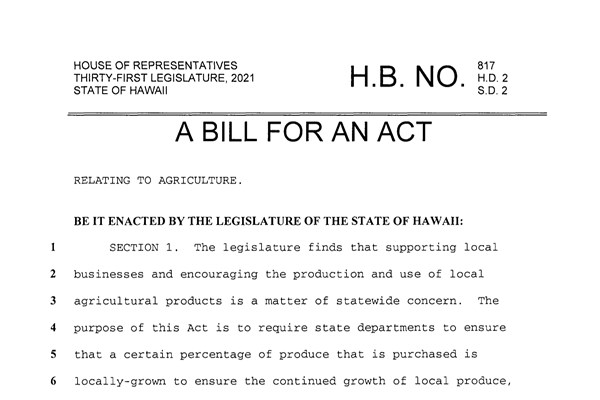Governor releases Intent to Veto List
Jun 24, 2021

On June 21, Gov. David Ige released his Intent to Veto List, indicating which bills may be on the chopping block and his rationale for concern. Among the bills he may potentially veto is House Bill 817 HD 2 SD 2, Relating to Agriculture, which requires each state department to ensure a percentage of the produce purchased by them is locally grown and to provide a report on progress to the State Legislature. HB817 sets goals beginning in 2025 at 10% of the total amount purchased, increasing incrementally every 5 years to 50% by 2050.
The Governor’s rationale for a possible veto is that “benchmarks set in this bill conflict with those set in HB767, which legislators also passed, requiring the Hawaii Department of Education to achieve a goal of 30% locally sourced agricultural products by 2030,” and that the measure “incurs significant budget costs for some departments, especially for the Department of Public Safety.”
Ulupono Initiative urges the Governor to reconsider, either by signing the bill or allowing it to become law without his signature. The benchmarks between HB817 and HB767 are complementary. The goals in each measure call for a minimum percentage to be met by a certain date; therefore, each bill’s goals do not conflict with one another as they establish a floor and not a ceiling. By passing legislation to expand local food purchasing goals to all state institutional programs, the Legislature is making a clear statement about the critical role of our state government to lead by example and buy local, if Hawaii is to address food insecurity and resilience. It’s been nearly seven years since the Governor announced his goal to double local food production. The 2019 State Legislature and the Governor passed a budget to create Farm-to-State positions within the state Department of Agriculture. Its time has come.
We believe the incremental nature of the benchmarks — nearly three decades to reach 50% locally sourced — allows sufficient time for departments to gradually ramp up to meet these admittedly ambitious but worthy goals. Additionally, through annual reporting, each state institution will be given the opportunity to highlight the successes and challenges faced at meeting these benchmarks. It may, in some cases, require departments to think outside the box or even request additional support from the state. We know first-hand that pilot projects in recent years at schools and hospitals on Kauai, Oahu and the Big Island successfully demonstrated expansion of local food procurement — and can even yield savings. There is sound indication that the same would be true at other state facilities with adequate buy-in and leadership. The expansion of this practice to other agencies through HB 817 supports the state’s effort to lead by example … not to mention the Governor’s own goal of doubling local food production.
Just as important are the reporting requirements along the way to ensure accountability. HB 817 is necessary to ensure our state government is making continuous progress and ultimately practicing what it preaches when it comes to buying local. If agencies believe a 50% by 2050 local food goal is too aggressive, then they owe it to the people of Hawaii to propose what would be attainable over the next 30 years.

